Abstract
OBJECTIVES--To study the incidence and management of intrinsic shoulder disorders in Dutch general practice, and to evaluate which patient characteristics are associated with specific diagnostic categories. METHODS--In 11 general practices (35,150 registered patients) all consultations concerning shoulder complaints were registered during a period of one year. Patients with an intrinsic shoulder disorder who had not consulted their general practitioner for the complaint during the preceding year (incident cases) were asked to participate in an observational study. Participants completed a questionnaire regarding the nature and severity of their complaints. The general practitioners recorded data on diagnosis and therapy. RESULTS--The cumulative incidence of shoulder complaints in general practice was estimated to be 11.2/1000 patients/year (95% confidence limits 10.1 to 12.3). Rotator cuff tendinitis was the most frequently recorded disorder (29%). There were 349 incident cases enrolled in the observational study. Patient characteristics showed small variations between different diagnostic categories. Age, duration of symptoms, precipitating cause and restriction of movement seemed to be discriminating factors. Twenty two percent of all participants received injections during the first consultation; most (85%) were diagnosed as having bursitis. The majority of patients with tendinitis (53%) were referred for physiotherapy. CONCLUSION--With respect to diagnosis and treatment, the practitioners generally appeared to follow the guidelines issued by the Dutch College of General Practitioners. Although the patient characteristics of specific disorders showed some similarities with the clinical pictures described in the literature, further research is required to demonstrate whether the proposed syndromes indeed constitute separate disorders with a different underlying pathology, requiring different treatment strategies.
Full text
PDF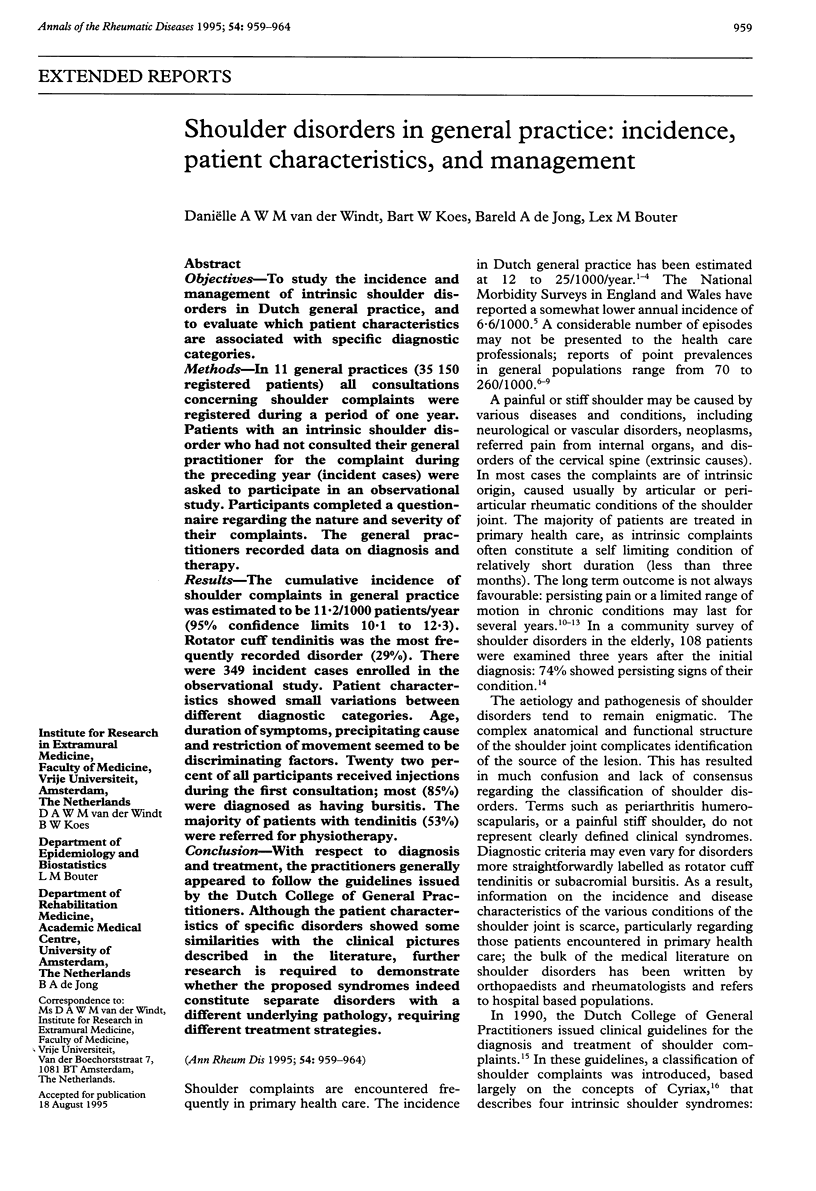
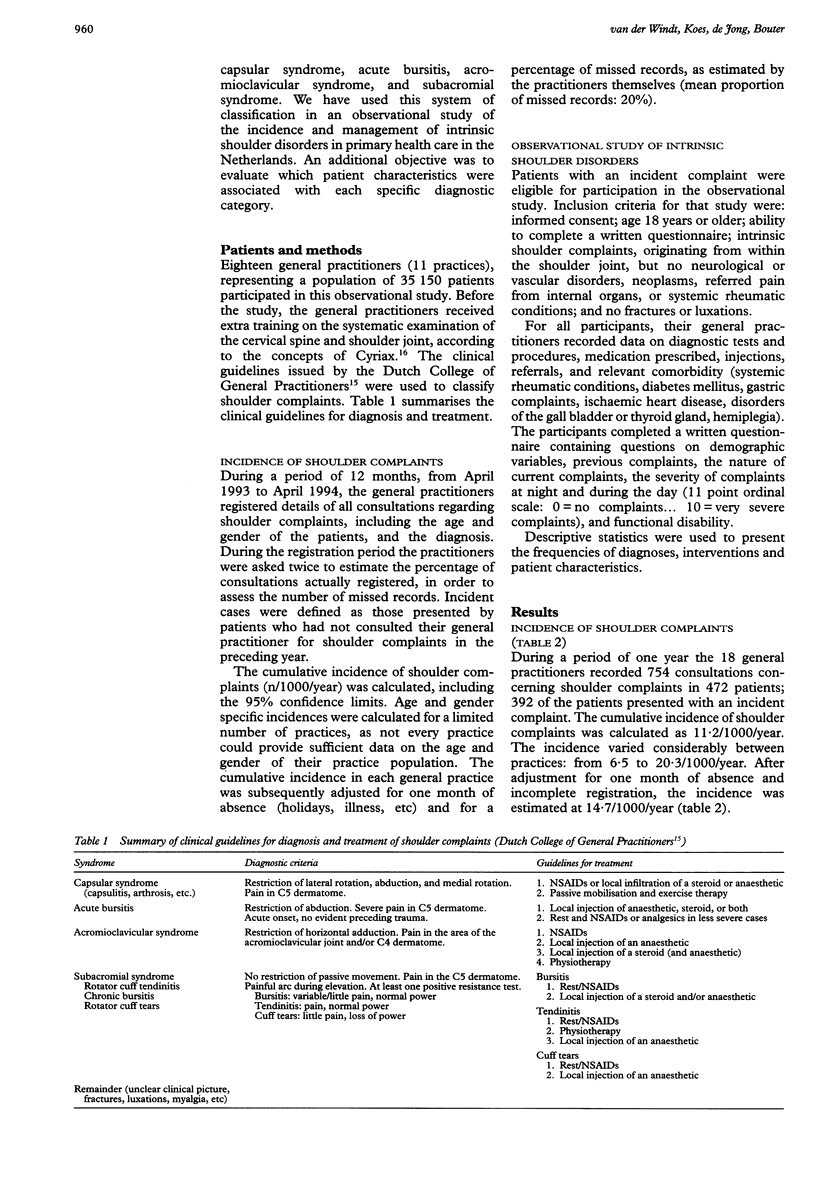

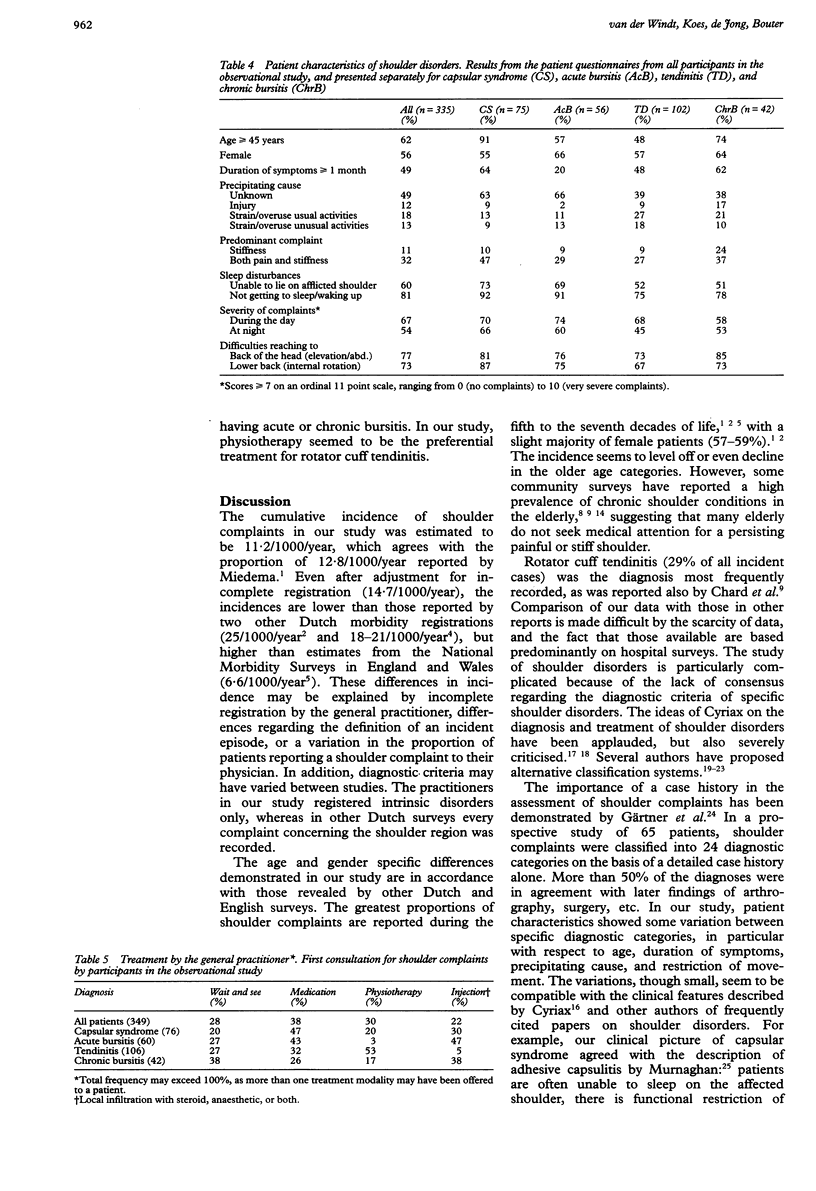
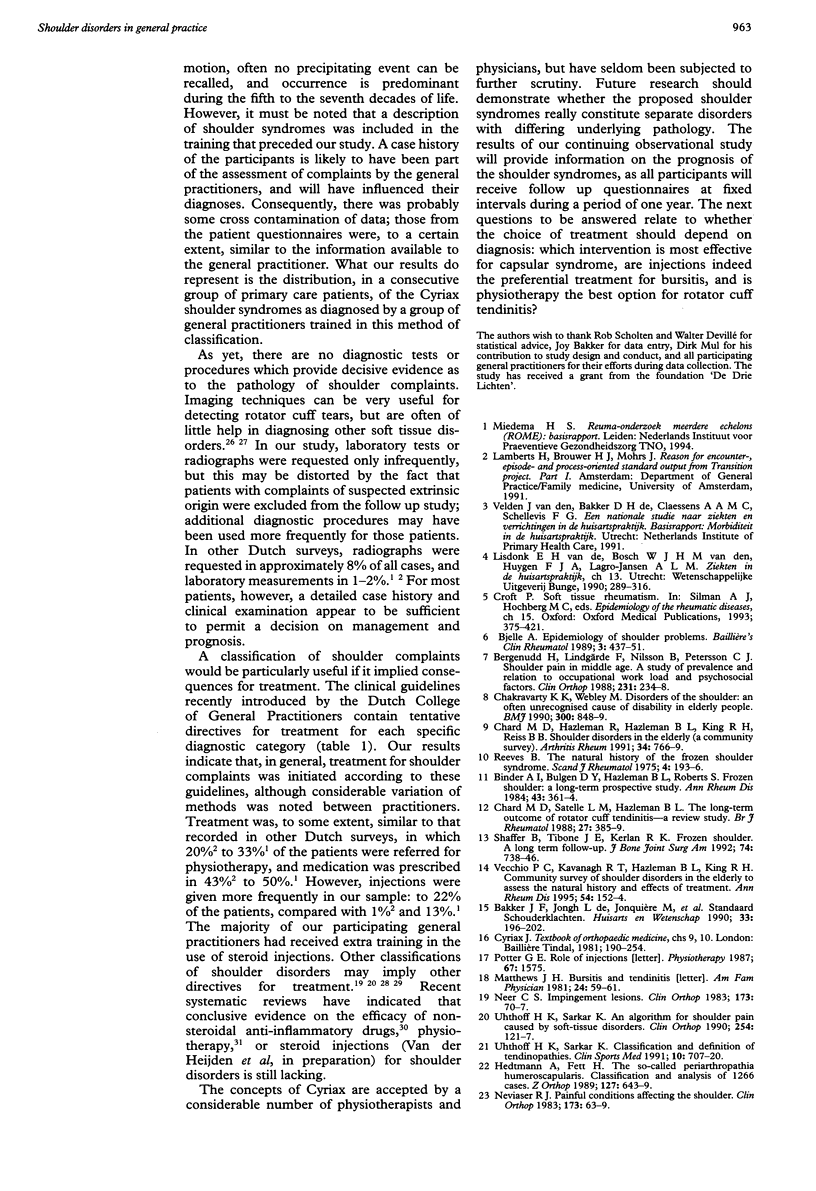
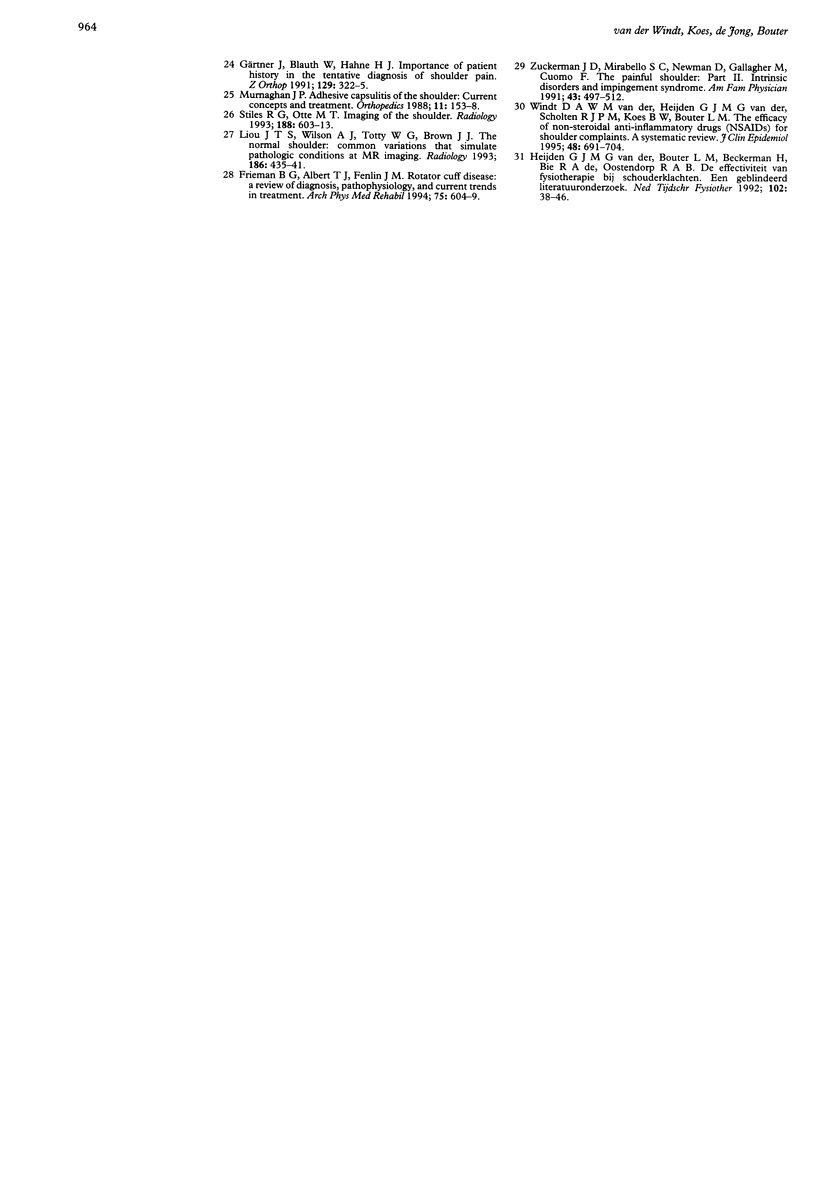
Selected References
These references are in PubMed. This may not be the complete list of references from this article.
- Bergenudd H., Lindgärde F., Nilsson B., Petersson C. J. Shoulder pain in middle age. A study of prevalence and relation to occupational work load and psychosocial factors. Clin Orthop Relat Res. 1988 Jun;(231):234–238. [PubMed] [Google Scholar]
- Binder A. I., Bulgen D. Y., Hazleman B. L., Roberts S. Frozen shoulder: a long-term prospective study. Ann Rheum Dis. 1984 Jun;43(3):361–364. doi: 10.1136/ard.43.3.361. [DOI] [PMC free article] [PubMed] [Google Scholar]
- Bjelle A. Epidemiology of shoulder problems. Baillieres Clin Rheumatol. 1989 Dec;3(3):437–451. doi: 10.1016/s0950-3579(89)80003-2. [DOI] [PubMed] [Google Scholar]
- Chakravarty K. K., Webley M. Disorders of the shoulder: an often unrecognised cause of disability in elderly people. BMJ. 1990 Mar 31;300(6728):848–849. doi: 10.1136/bmj.300.6728.848-a. [DOI] [PMC free article] [PubMed] [Google Scholar]
- Chard M. D., Hazleman R., Hazleman B. L., King R. H., Reiss B. B. Shoulder disorders in the elderly: a community survey. Arthritis Rheum. 1991 Jun;34(6):766–769. doi: 10.1002/art.1780340619. [DOI] [PubMed] [Google Scholar]
- Chard M. D., Sattelle L. M., Hazleman B. L. The long-term outcome of rotator cuff tendinitis--a review study. Br J Rheumatol. 1988 Oct;27(5):385–389. doi: 10.1093/rheumatology/27.5.385. [DOI] [PubMed] [Google Scholar]
- Frieman B. G., Albert T. J., Fenlin J. M., Jr Rotator cuff disease: a review of diagnosis, pathophysiology, and current trends in treatment. Arch Phys Med Rehabil. 1994 May;75(5):604–609. [PubMed] [Google Scholar]
- Gärtner J., Blauth W., Hahne H. J. Die Bedeutung der Anamnese für die Wahrscheinlichkeitsdiagnose von Schulterschmerzen. Z Orthop Ihre Grenzgeb. 1991 Jul-Aug;129(4):322–325. doi: 10.1055/s-2008-1040249. [DOI] [PubMed] [Google Scholar]
- Hedtmann A., Fett H. Die sogenannte Periarthropathia humeroscapularis--Klassifizierung und Analyse anhand von 1266 Fällen. Z Orthop Ihre Grenzgeb. 1989 Nov-Dec;127(6):643–649. doi: 10.1055/s-2008-1040306. [DOI] [PubMed] [Google Scholar]
- Liou J. T., Wilson A. J., Totty W. G., Brown J. J. The normal shoulder: common variations that simulate pathologic conditions at MR imaging. Radiology. 1993 Feb;186(2):435–441. doi: 10.1148/radiology.186.2.8421747. [DOI] [PubMed] [Google Scholar]
- Matthews J. H. Bursitis and tendinitis. Am Fam Physician. 1981 Oct;24(4):59–61. [PubMed] [Google Scholar]
- Murnaghan J. P. Adhesive capsulitis of the shoulder: current concepts and treatment. Orthopedics. 1988 Jan;11(1):153–158. doi: 10.3928/0147-7447-19880101-15. [DOI] [PubMed] [Google Scholar]
- Neer C. S., 2nd Impingement lesions. Clin Orthop Relat Res. 1983 Mar;(173):70–77. [PubMed] [Google Scholar]
- Neviaser R. J. Painful conditions affecting the shoulder. Clin Orthop Relat Res. 1983 Mar;(173):63–69. [PubMed] [Google Scholar]
- Potter G. E. Role of injections. Phys Ther. 1987 Oct;67(10):1575–1575. doi: 10.1093/ptj/67.10.1575. [DOI] [PubMed] [Google Scholar]
- Reeves B. The natural history of the frozen shoulder syndrome. Scand J Rheumatol. 1975;4(4):193–196. doi: 10.3109/03009747509165255. [DOI] [PubMed] [Google Scholar]
- Shaffer B., Tibone J. E., Kerlan R. K. Frozen shoulder. A long-term follow-up. J Bone Joint Surg Am. 1992 Jun;74(5):738–746. [PubMed] [Google Scholar]
- Stiles R. G., Otte M. T. Imaging of the shoulder. Radiology. 1993 Sep;188(3):603–613. doi: 10.1148/radiology.188.3.8351318. [DOI] [PubMed] [Google Scholar]
- Uhthoff H. K., Sarkar K. An algorithm for shoulder pain caused by soft-tissue disorders. Clin Orthop Relat Res. 1990 May;(254):121–127. [PubMed] [Google Scholar]
- Uhthoff H. K., Sarkar K. Classification and definition of tendinopathies. Clin Sports Med. 1991 Oct;10(4):707–720. [PubMed] [Google Scholar]
- Vecchio P. C., Kavanagh R. T., Hazleman B. L., King R. H. Community survey of shoulder disorders in the elderly to assess the natural history and effects of treatment. Ann Rheum Dis. 1995 Feb;54(2):152–154. doi: 10.1136/ard.54.2.152. [DOI] [PMC free article] [PubMed] [Google Scholar]
- Zuckerman J. D., Mirabello S. C., Newman D., Gallagher M., Cuomo F. The painful shoulder: Part II. Intrinsic disorders and impingement syndrome. Am Fam Physician. 1991 Feb;43(2):497–512. [PubMed] [Google Scholar]
- van der Windt D. A., van der Heijden G. J., Scholten R. J., Koes B. W., Bouter L. M. The efficacy of non-steroidal anti-inflammatory drugs (NSAIDS) for shoulder complaints. A systematic review. J Clin Epidemiol. 1995 May;48(5):691–704. doi: 10.1016/0895-4356(94)00170-u. [DOI] [PubMed] [Google Scholar]


